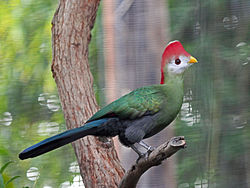| Red-crested turaco | |
|---|---|
 | |
| Red-crested turaco, Niagara Falls Aviary, Canada | |
| Scientific classification | |
| Kingdom: | Animalia |
| Phylum: | Chordata |
| Class: | Aves |
| Order: | Musophagiformes |
| Family: | Musophagidae |
| Genus: | Tauraco |
| Species: | T. erythrolophus |
| Binomial name | |
| Tauraco erythrolophus (Vieillot, 1819) | |
The red-crested turaco (Tauraco erythrolophus) is a turaco, a group of African otidimorph birds. It is a frugivorous bird endemic to western Angola. Its call sounds somewhat like a jungle monkey.





